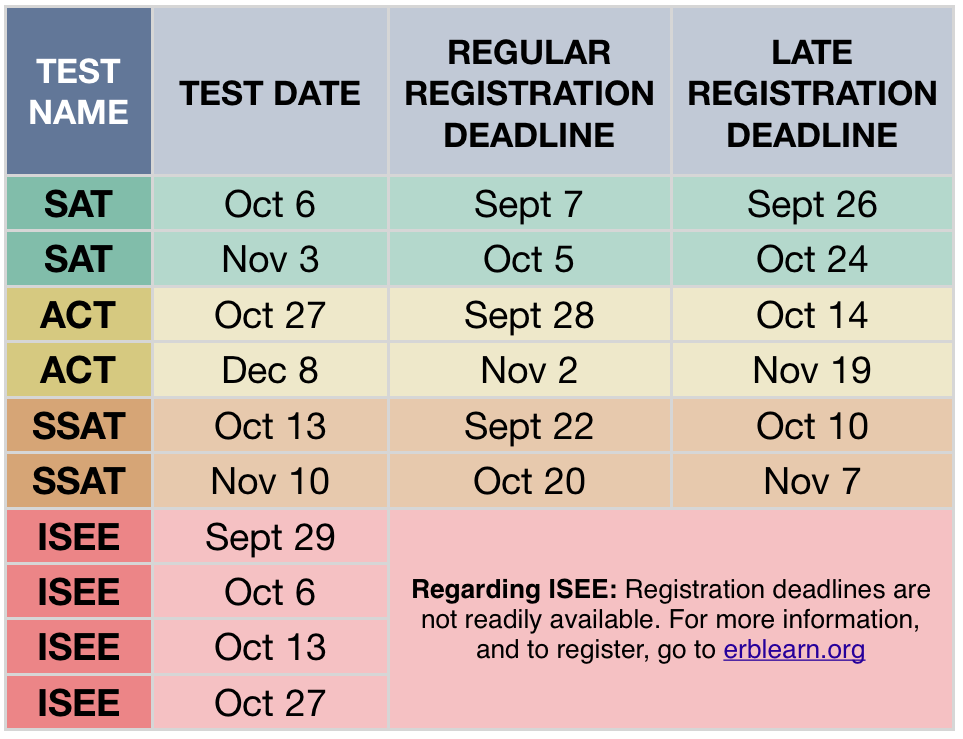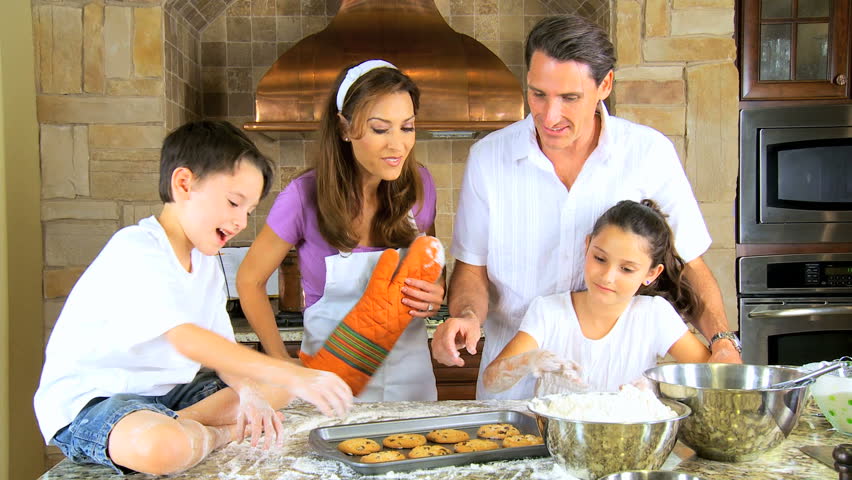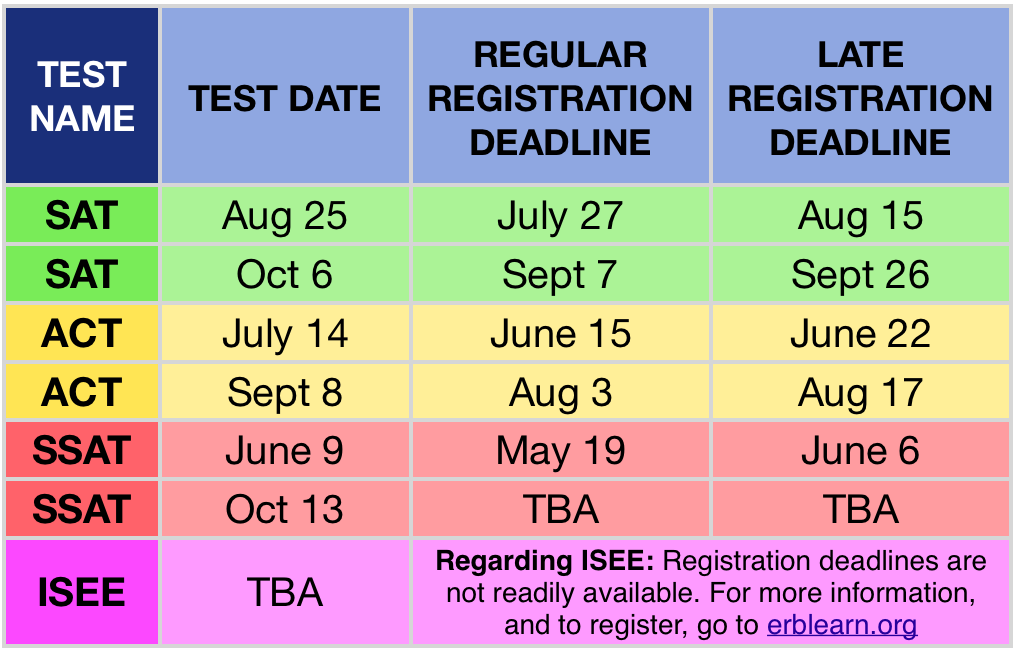Mark your calendar for the latest test dates.
Talking to Your Child About Events in the News
It seems that the world is stressed by current events and inevitably it’s trickling down into our home and family, whether we realize it or not. The news comes not only from the television, but also from the radio, from overheard conversations while we’re out and about, and from friends. These days, it seems like we can’t get away from it. So how do we deal with talking to our children about current events and making sure that they’re not badly affected?
Let’s start with the television. The imagery and sounds being broadcast during scary news stories are pretty hard to avoid. Natural disasters such as the recent hurricanes, world-wide conflicts, national politics and events, and overtly sexual talk is easier to witness than it’s ever been before, thanks to not only the television but also the growing use of computers and smart phones. As parents, you want to make sure that these scary and not always child-appropriate real-life events don’t end up traumatizing your child.
Exposing our children to daily events isn’t necessarily a bad thing. We just need to make sure that we’re aware of what they’re seeing and that they have a correct understanding of what is going on. For example, tapes from 9/11 were recently played throughout the day and night memorializing those who lost their lives and honoring first responders and rescuers. That could be a frightening event for our children to see, so talking about the videos, explaining why they’re being played, and assuring them that this tragedy isn’t happening in real-time, is important so they don’t think they are in imminent danger.
Another facet of news reporting is the replaying of sensational photos and other graphic video clips. Replaying emotionally tough events is hard on us adults, so imagine how hard it is for your children. They may not even recognize that they’re watching repeated clips. Best thing to do? Turn off the television if a traumatic event is being re-broadcast and limit your child’s exposure. Visual images can greatly affect our children, often even more than hearing the words used during the reporting, and it can be hard on us as adults as well! As another example, video and photos showing the devastation from Hurricane Florence often included destroyed homes, family rescues, evacuations, and collapsing roads. This is hard to take in, especially when small children and vulnerable animals are shown. Limiting these graphic images is important.
Sit with your children if you find them watching the news or they’re seeing news clip between their show breaks. Explain the basics of what is going on, answer any questions that they may have but don’t over-explain, and get out a map to offer some much-needed perspective to what they’re seeing. The flooding, the devastation, the soldier going to the hospital is not happening across town, but is occurring halfway across the country or on the other side of the world. Young children will need to have this pointed out to them so they can understand that they, their families, and their beloved pets are not in danger.
That said though, take their fears seriously. Don’t blow them off just because the event is happening hundreds or thousands of miles away. Encourage them to express aloud what they’re thinking, especially if you’re noting any change in their behavior. Ask open-ended questions about what they saw, about their concerns, about their fears, and in this way, you won’t run the risk of overwhelming them with more information than they can handle or from over-explaining, thus creating an even bigger emotional event.
For older children, you might want to help them to understand more about hurricanes, earthquakes, landslides, or whatever natural disaster has happened. It may actually relieve their fears and concerns and with you by their side, there will be less of a chance that misunderstandings of the event occur.
Be there for your children. Whether it’s evident or not, they are looking to you for guidance and are watching you to gauge your response to what is going on. Be a calming influence. Keep calm, no matter what upsetting story is being reported or nightmarish image is flashing across the screen. Acknowledge your children’s feelings and fears, and reassure them that the family, their home, and their pets are safe.
During upsetting events, keep the family’s daily routine as normal as possible. This will be another visible way to help your children understand that life goes on even when bad events are happening. Be willing though, to add extra time for support and comfort during those times when it’s needed.
You’re heard of play therapy. There’s a reason that this is an effective tactic that is used with children who are stressed. Children often re-enact their fears, worries and experiences as a way of coping. Encourage play. It’s a way to release stress.
Watch how you talk about the event and see if you can’t emphasize anything positive that is going on, rather than just focusing on the negative. Instead of talking about “bad people” or imminent danger of a situation, cheer for the rescuers and organizations that are helping the people and animals who are in trouble or hurt. Another tact along those lines is to act as a family to be a part of the solution. In the event of a crisis or emergency, help to collect clothing, food, or money donations and personally deliver them to the organizations that are engaged in relief work, put in some time volunteering, or consider ways to help raise awareness. Doing something to help and getting involved in acts of charity not only help to reduce stress and fear caused by a crisis, but also sets healthy groundwork for volunteerism when they’re older.
Whatever the story is on the news, whatever the conversation overheard or series of disturbing images being shown on our household screens, be involved in helping your children to correctly understand what is happening. Help them to express their thoughts and fears about what they’re seeing and hearing, and take this opportunity to help your child engage with the community in a helpful and healthy way.
You Can Do It: Shadow Box Jack-o-Lantern
Are you ready to create a different kind of Jack-O-Lantern this season? You’ve carved hundreds of spooky and goofy faces onto those beloved orange orbs, but how about shaking it up this year! This idea from Crazy Little Projects will be a super fun project for the family.
Here’s what you need:
Carve-able craft pumpkins from your local art/craft supply store
Black cardstock (orange or yellow work well too)
Tea Lights (if you get the Halloween kind they will even flicker)
Clay
Popsicle sticks
Transparent thread or fishing line
Hot Glue
Here’s how to do it:
Use a small kitchen knife to carve out a large circle from your carve-able pumpkin.
Take your cardstock and cut out the figures you’d like to have inside your scene. (think spooky cats, bats, broomsticks, houses, witches, ghosts, whatever you’d like!)
Place a layer of clay on the bottom of the inside of your pumpkin.
Glue popsicle sticks onto the backs of your figures and anchor them into the clay. It might be easiest to start with the larger figures and then work on the smaller pieces.
For the cut-outs that you want hanging from the top of your scene, glue a piece of transparent thread or fishing line to the back of your piece and then hot glue the other end of the thread to the top of the pumpkin. This may work best if you wait until the glue is mostly cool and then press your finger against it to get the string to stay in place.
When you’re finished assembling your scene, place a tea light behind one of the larger cutouts and use it to illuminate your Jack-O-Lantern at night. This fun new Halloween shadowbox will look great both during the day and at night!
Letter from Betty for September 2018
Hello Friends,
September is here and with it a new school year begins! For parents of juniors and seniors, there is not only this academic year to focus on — there is also looking ahead, researching, and planning trips to find the perfect college. In our feature article, "Keys to a Successful College Visit," find advice on how to make those trips worthwhile.
For parents of younger students, you'll find back-to-school inspiration in hand-crafting an artistic school bag. Our bonus article will add creative color and fun to all the book toting to come: "You Can Do It: Apple Print Bags." Enjoy!
Whatever your educational needs, Foundation for Learning is ready to assist you with caring, one-on-one, individualized tutoring, and ISEE/SSAT test prep.
Don't hesitate to give us a call at 973-425-1774 or send an email to betty.foundationforlearning@gmail.com for a free consultation.
Best regards,
Betty
September 2018 Test Schedule
Mark your calendar for the latest test dates.
Keys to a Successful College Visit
Advice for parents of high school seniors and juniors
As the "college visit" season is upon us, keep in mind that the tours are designed to show the campus’ high points, finer points, and best dress. So make sure you dig a little deeper to really find out what student life is like at this prospective new home. The next 4-plus years are going to be spent there and a not-so-small amount of money paid to the institution, so finding out the most you can about a school is the only way to go. You need to look beyond the student tours.
Here are some suggestions:
1. Don’t plan your visit for when the campus is lonely during summers or breaks, instead tour while classes are in session. You’ll get a much better feel for the environment if you visit during regular semesters and your teen will get a better sense of what it will be like to navigate around campus with throngs of other students. She will also see first hand where the students spend time between classes and after a day of classes, and how easy it is to maneuver around campus.
2. The tour is likely to take you through the most beautiful, well-kept areas of campus. After the tour, take another stroll around and really look. Are the buildings is good shape? Is the library well stocked and welcoming? Does the campus look safe and well lit?
3. If the tour doesn’t include a stop at a typical freshman dorm, either ask to see one or, if allowed, make sure to pop in one during your post tour walk-about. Hopefully you’ll stroll past a few open doors in the hallway and take a glance as you make your way down the hallway so you can see what freshman dorm life is really like, not just see the “show” room that is presented on the tour. Also, note how far it is from the dorms to the classrooms.
4. It probably will be tempting to celebrate this adventure with a meal out at a nice local restaurant, but it would be a good idea to visit the campus cafeteria and have a meal there as well. What are the other dining options on campus? Is the food pleasing and the eating area clean? Is it busy with students or do you suspect that many are eating off campus? Are the hours suitable for early birds and night owls? Pick up a copy of the weekly menu if you can, just to see the options. Are there a lot of choices and if your teen is on a restricted diet, will they be able to provide the appropriate food?
5. Ask the college admissions office if you can sit in on a typical freshman class, or if your teen already has a major in mind, then a class within that department. If that’s not possible, then take a walk through a few hallways, tarry a bit, and discreetly listen to what is going on inside. If possible, stop a professor, particularly in your teen's preferred area of study, and ask a few questions. If he's not racing to class, he'’ll likely take the time to visit with you.
6. While walking around the campus, politely stop other faculty and students. Explain that you’re visiting the school, trying to get a feel for what it’s like, and in the process of deciding if the school is right for your child. Ask pointed questions, but ask for their opinions as well. Do they enjoy going to school there? Do they like living in the dorms? What should an incoming freshman know? Be sure to ask open ended questions so you don’t just get yes/no answers. If they’re not racing to class, they’ll probably be happy to talk to you or can refer you to someone who can answer your questions.
7. Then there’s the all-important social life. Look at the posters, fliers, and calendars around campus and in town too. Do the events look appealing and peek your child’s interest? Are there a variety of events and programming available? Are there events on the weekends as well? You’ll want to see if there are activities to do on the weekends, if not, it may be an indication that the school you’re visiting is a “suitcase” school, where students don’t stick around. Does the school itself offer social programming? As much as you may want your teen to love her classes and spend a lot of time studying, if she doesn't like the social life on and around campus, then she's not likely to be happy at the school.
This is an exciting time in the life of your family. By doing a bit of research before heading out on your college tour, by taking the tour and then doing your behind-the-scenes tour as well, you’re bound to help your child pick a school where she can be happy and thrive.
You Can Do It: Apple Print Bag
From Martha Stewart comes a really fun back-to-school project that will be super fun to do and the kids will be proud to show off to their classmates!
Apples aren't just for eating. The cut side of an apple half, dipped in candy-colored paint, can be stamped onto otherwise ordinary canvas tote bags and backpacks.
Materials
- Apple
- Knife
- Paintbrush
- Paint
- Markers (optional)
Steps
- Cut an apple in half from top to bottom. Make sure the cut is smooth and flat. Use a paintbrush to apply the paint evenly over the cut side of the apple.
- With the apple half, cut side down, stamp the surface of the object you want to decorate. The more times you stamp, the less vivid the print will be, so reapply paint, or use the other half.
- Use additional apple halves to print with different colors, if desired. Use black or green markers to draw stems and leaves.
Letter from Betty for August 2018
Hello Friends,
A new school year is coming soon, but before we get back to the books, let's see if we can squeeze one final quick adventure into this fleeting summer! In our feature article for August, we uncover some lesser known treasures of our own Jersey Shore in "7 Unique Jersey Shore Spots You've Likely Missed."
Say this out loud as fast as you can: "Sharpie seashells, Sharpie seashells, Sharpie seashells." Phew! Now that makes for a classic tongue twister. It is also the subject our our bonus feature for August, "You Can Do It: Sharpie Seashells." Get out your fine-tipped pens and best beach-combing finds and enjoy!
Whatever your educational needs, Foundation for Learning is ready to assist you with caring, one-on-one, individualized tutoring, and ISEE/SSAT test prep.
Don't hesitate to give us a call at 973-425-1774 or send an email to betty.foundationforlearning@gmail.com for a free consultation.
Best regards,
Betty
August 2018 Test Schedule
Mark your calendar for the latest test dates.
7 Unique Jersey Shore Spots You’ve Likely Missed
The first day of school is looming in our thoughts these days. If you are you heading to the Shore one more time before bidding farewell to summer, we have 7 interesting, educational, unique, and just plain fun destinations for you to visit. There’s still time to build those summertime memories!
Bivalve?
Once a prosperous oystering town, the tiny hamlet of Bivalve is home to the Rutgers shellfish research laboratory, The Bayshore Center and the Delaware Bay Museum is a unique place where you can step back in time to the 1920’s and visit the thriving oyster industry of Maurice River Cove. Exhibits there engage visitors in the living history of the Delaware Bay through hands-on, interactive, and inquiry-based exhibits. Bivalve is also home to New Jersey's official tall ship, the A. J. Meerwald(see photo above) which offers programs and sailing adventures not to be missed. Bivalve's salt marsh provides a vital habitat for plants and animals, including migrating birds and spawning species. Enjoy 5 miles of walkways, birding sites, observation platforms, and the best sunsets ever! Bivalve is well worth exploring.
South Cape May Meadows Preserve – a birder’s dream!
Did you know that one of the prime viewing spots for birding on the east coast is right here in New Jersey? At South Cape May Meadows in West Cape May and Lower Township you’ll find 200 acres of dunes, wetlands, meadows, and a mile of protected beach. Bear in mind that beach use is restricted to nature viewing only from March 15-August 31. The trails are marked if you want to stroll on your own, but you might want to consider a guided walk offered by the New Jersey Audubon’s Cape May Bird Observatory. Make sure to bring along your binoculars!
Sedge Island
Pack a picnic and head to New Jersey’s first marine conservation zone! Sedge Island is a bit of Eden right in the middle of the Barnegat Bay. Visit the Sedge Island Natural Resource Education Center and learn about the uniqueness of the area, including the fact that the island is a protection site for the diamondback terrapin that breeds there. Kayaking tours, marsh walking, birding, crabbing and clamming, and no crowds, no noise, no traffic. What could be better?
Mantoloking Bridge County Park
This two-and-a-half-acre park has been beautifully reconstructed after being hit by Hurricane Sandy and is a lovely place for the family to spend the day picnicking, fishing, crabbing, and enjoying park activities. You can avoid the summertime crush at the Shore and enjoy the awesome waterfront views, 70- foot long pier, boardwalk and gazebo. This is a beautiful place to quietly spend some family time before summer’s end. The park is located on the Brick side of the bridge over Barnegat Bay leading into Mantoloking.
The Giant Wheel, Wildwood
Visible from the Garden State Parkway, Wildwood’s Giant Wheel stands 15 stories high and is illuminated with 92,400 lights. It was delivered by boat 33 years ago, originating from Holland. There are, of course, many other rides on the pier, but the Giant Wheel can’t be overlooked. The best time to ride is at night, when you’ll rise far above the crowds and enjoy the magnificent vista. Might as well enjoy some sugary funnel cake while you’re there!
Is it a whale? An antique rocket ship?
For a really different destination, head to Sea Girt and visit the National Guard Militia Museum of New Jersey. That 28-foot-long concrete egg-shaped vehicle is an actual hand-cranked submarine, planned to be the great secret weapon of the Civil War. It’s certainly the oddest vessel to be found there, but in the collection, you’ll also find an amphibious Jeep vehicle, the only automobile to have circumnavigated the globe.
Absecon Lighthouse
Everyone knows about the Cape May Lighthouse and Old Barney on LBI, but the tallest lighthouse in New Jersey is the Absecon Lighthouse in Atlantic City. It’s the only lighthouse in the state with its original first-order Fresnel lens. Visitors can climb the 228 steps to get to the top and there they’ll be rewarded with a breathtaking 360-degree panorama. The Absecon Lighthouse is 171 feet tall, 161 years old, and remains the third tallest lighthouse in the US.
So there you have it! Seven great ideas for unique places to visit with your family before you getting back into school-mode. Check out their individual websites for more information, including fun educational programs and creative opportunities. Have fun making memories!
You Can Do It: Sharpie Seashells
You’ve been to the shore and inevitably you’ve come home with bags of shells that the kids have collected. Here’s a fun and beautiful project that is appropriate for most any age. All you need is a selection of shells (shells with ridges work best) cleaned up and dried off, and a thin-tip Sharpie marker. Take a look at this photo for inspiration, and let your imagination run wild!
Letter from Betty for July 2018
Hello Friends,
After graduating from school and becoming a young adult, you probably continued your learning by delving into areas that were of particular interest to you. Fortunately, all of life can be viewed as "continuing education" since we can, and often do, continue to discover new facets of the world around. While you don't have to be explicit about your plans for your children this summer, you can be intentional about keeping the learning going. We have some great ideas about this in our feature article for July, "Using Cooking To Teach Math and Science."
To give you some very specific ingredients, directions, and inspiration for family cooking (and math and science) time, we have tasty suggestions in our bonus article for this month: "You Can Do It: Recipes!" Enjoy!
Whatever your educational needs, Foundation for Learning is ready to assist you with caring, one-on-one, individualized tutoring, and ISEE/SSAT test prep.
Don't hesitate to give us a call at 973-425-1774 or send an email to betty.foundationforlearning@gmail.com for a free consultation.
Best regards,
Betty
July 2018 Test Schedule
Mark your calendar for the latest test dates.
Using Cooking To Teach Math and Science
Cooking is a creative and active way to keep young minds working and learning over the summer break. It's an excellent way to help kids focus on math and science without them know it. Get everyone into the kitchen and get cooking!
Cooking involves basic math and science. It includes fractions and measurement as well as chemical and physical reactions, observation, and data collection. There’s also a yummy reward at the end of every lesson. What better motivation for your children to join in!
Think about it:
- Water is a perfect ingredient to use to talk about liquid, gases, and solids, and it’s something we all use every day.
- Cookie dough starts out soft when the treats come out of the oven but hardens as they cool. Cake and brownie batter is in liquid form prior to baking, but once baked it becomes a solid form. And let’s not forget about pancakes! Liquid batter reacts to the hot griddle by solidifying, then delicious solid butter melts and drip over the top. Breakfast is served!
- Finally, when frozen, cream miraculously (with a few added tasty ingredients) becomes ice cream!
Physical changes happen as temperature changes. What a fun way to teach how temperature affects states of matter!
There are also chemical reactions that occur when making pancakes or baked goods. Yeast, baking soda, and baking powder, with the help of a bit of sugar and salt, cause great chemical reactions. You can show your children the bubbles that develop when carbon dioxide is created by combining ingredients. They can watch and understand why their baked goods rise. Now that’s a tasty chemical reaction!
But what about math? Cooking involves counting, ordering of steps, computation, volume, fractions, and weight measurements.
Get everyone into the kitchen this summer and whip up delicious meals and treats. They’ll never know that they’re working on science and math over their summer vacations!
You Can Do It: Recipes!
Chocolate Chunk Cookies
Ingredients:
- 2 cups plus 3 tablespoons all-purpose flour
- 3/4 teaspoon kosher salt
- 3/4 teaspoon baking soda
- 2 sticks unsalted butter, at room temperature
- 1 cup granulated sugar
- 1/3 cup dark brown sugar
- 2 large eggs
- 1 1/2 teaspoons pure vanilla extract
- 1 (5-ounce) block semisweet chocolate, chopped into chunks
Directions:
Preheat the oven to 375 degrees F. Line baking sheet with parchment paper or silicon pads.
Whisk together the flour, salt and baking soda in a large bowl.
Place the butter in the bowl on an electric stand mixer fitted with paddle attachment and beat until smooth, about 1 minute. Add the sugars and continue mixing, scraping down the sides and bottom of the bowl until light and fluffy, about 2 minutes longer.
Add the eggs, 1 at a time, and the vanilla extract, beating until incorporated. Add half of the flour and mix until just incorporated. Add the remaining flour, again mixing until just combined. Remove the bowl from the stand and fold in the chocolate chunks.
Using a small ice cream scoop, spoon the dough onto a baking sheet, leaving at least 2 inches between each cookie and bake on the middle rack until the cookies are lightly golden brown and still soft in the middle, about 11 minutes. Let cookies rest for 2 minutes on the baking sheet before removing them to a baking rack with a wide metal spatula. Let the cookies cool on the baking rack for a few minutes before eating. Repeat with remaining dough.
Banana Pancakes
Ingredients:
- 1 1/2 cups all-purpose flour
- 1 tablespoon sugar
- 1/2 teaspoon salt
- 1 teaspoon baking soda
- 1 teaspoon baking powder
- 1 large egg
- 1 cup buttermilk
- 1/4 cup whole milk
- 1 tablespoon melted unsalted butter, plus 3 tablespoons
- 3 ripe bananas, cut into 1/3-inch slices
Directions:
Preheat oven to 200 degrees. In large bowl sift together flour, sugar, salt, baking soda and baking powder. In separate bowl whisk together egg, buttermilk, milk and melted butter. Slowly combine the dry ingredients with the wet ingredients. Stir until the flour disappears, but being careful not to over beat the batter. In a large cast-iron skillet, melt about 1/2 tablespoon remaining butter. Ladle about 1/4 cup of batter into the pan for each pancake. Immediately press 4 or 5 banana slices into each so the batter oozes slightly over the fruit. Cook until bubbles appear and then flip and cook on the other side, about 3 minutes total. Transfer the pancakes to a platter and keep warm in the oven while you cook the remaining batches, adding butter to the pan as needed. Serve hot with syrup.
No-Churn Strawberry Ice Cream
Ingredients:
- 1 pound frozen strawberries, thawed at room temperature for 10 minutes
- One 14-ounce can sweetened condensed milk
- 1 teaspoon pure vanilla extract
- Pinch fine salt
- 2 cups heavy cream, cold
Directions:
Special equipment: A 9-by-5-by-3-inch metal loaf pan, chilled
For the ice cream: Pulse the strawberries in a food processor until you achieve pea-size chunks. Add the condensed milk, vanilla and salt. Pulse to combine; remove to a medium bowl and set aside.
Whip the cream with a mixer on medium-high speed until firm peaks form, about 2 minutes. Fold about 1 cup of the whipped cream into the strawberry mixture with a rubber spatula until combined, then fold the lightened mixture into the whipped cream until well blended. Pour into a chilled 9-by-5-by-3-inch metal loaf pan, and freeze, covered, until thick and creamy, like soft-serve, about 2 hours. Swirl in any desired mix-ins with a spoon. Continue to freeze, covered, until solid and scoopable, about 3 hours more.
Letter from Betty for June 2018
Hello Friends,
Have you ever heard of a person who "never met a stranger"—someone who gets along well with just about everyone, in every circumstance? That is certainly an admirable skill. One of the first strategies in becoming such a confident "people person" is to treat everyone you meet as an individual, rather than a member of a group. In our feature article this month, we offer ideas on how children can develop valuable social skills in "Helping Children Resist Stereotyping."
Summer beckons us to run out into the warm sunshine for outdoor fun and adventure. But in the midst of a myriad of get-up-and-go distractions, don't forget to encourage your children to pursue quiet creative projects in the cool shade. We've got ideas in our bonus article for June, "Guided Creativity for Summertime Fun." Happy creating!
Whatever your educational needs, Foundation for Learning is ready to assist you with caring, one-on-one, individualized tutoring, and ISEE/SSAT test prep.
Don't hesitate to give us a call at 973-425-1774 or send an email to betty.foundationforlearning@gmail.com for a free consultation.
Best regards,
Betty
June 2018 Test Schedule
Mark your calendar for the latest test dates.
Helping Children Resist Stereotyping
Parents know that how they speak to their children and other adults has a tremendous impact on their children.They are sponges, soaking up the world around them, internalizing what they hear, and mimicking back those thoughts, ideas, and beliefs. It’s important that they are aware of their words and actions if they want to help erase the generalizations that lead to many problems in our society.
It’s a sad truth that by the time children enter the elementary grades, race and gender ideas already shape their experience. It’s been repeatedly shown that in these early years, girls are less likely to think they are as smart as the boys in their class. These thoughts, as well as beliefs about racial differences, actually also shape behavior. It effects how children choose activities, who they choose to group with, and what they think about themselves. These thoughts and early beliefs contribute to their long-term gender and racial ideas.
Where do these stereotypes come from? Early social and cognitive experiences contribute heavily to the tendency to view the world in a particular way. How parents speak can be more important that the actual words they use. Generalizations can send the message that we can tell what a person is like just by knowing certain things about them, like their religion, where they live, their dress, their ethnicity or their gender. Parents need to talk about people as individuals rather than as a homogeneous group. If children only hear information presented as a generalization, they’ll likely start thinking in terms of “us” and “them.” “They” are different from everyone else and being a member of that group dictates what a member of that group will be like. Hearing these broad statements, even if they’re positive, contributes to the likelihood that children will view their world through these lenses, even into adulthood. Their way of thinking about people, the assumptions they make, and their own behaviors can be impacted.
Parents need to be careful to use specifics rather than general claims. “That girl is great at math,” “That family is vegetarian and doesn’t eat meat,” “His family lives in an apartment,” “That mother plays the guitar,” Talking about an individual and using specific language steers a conversation or the thinking away from generalizing about a whole group, gender, race or religion of people.
If your children make a sweeping statement about a group of people, guide the conversation and find out what/who they are specifically thinking of, and you may find that they have someone specific in mind. You can then encourage them to consider the individual and lead them away from making a generalization. Bear in mind though, that early on, children speak out in this way because they’re “testing the waters,” to see if their thinking is correct. Your reply as a parent is valuable at this point, so be aware of the words you use when you respond.
Obviously, parents can’t control their children’s exposure to all instances of gender and racial stereotyping they’ll likely experience during their day, but parents do have a significant influence in setting the stage for and accepting and understanding a healthy set of societal values and norms. Children are listening, watching, learning, and developing their sense of how the world works and adults need to understand that every interaction with them counts, from their tender young age through their teens and into young adulthood. Parents can launch healthy, compassionate, caring offspring into the community and the world, with a point of view that challenges rather than sanctions the stereotyped perspective of the people and situations they may encounter. To paraphrase the song, we canteach our children well.
Guided Creativity for Summertime Fun
This month we have a suggestion for unique summertime fun. Guided creativity books provide fabulous quiet-time entertainment. Nurturing creativity with a series of prompts, these books help to spark imagination, foster inventiveness, and encourage your child or teen to perhaps start looking at the world a little differently.
Our teen recommendation is a book by Austin Kleon called The Steal Like an Artist Journal. It is an interactive journal, a place to get creative juices flowing and a fun way to keep a log of ideas, thoughts and discoveries. This is not a kid’s book at all, parents might want to purchase one for themselves and explore the prompts that lead the reader to think about things in an all new way, to let their creativity run wild and unfettered.
For younger children, Ed Emberley Drawing Books, is a series full of fun items to draw and definitely is not a “color within the lines” experience. You may want to sit next to your child to help explain the various activities, but the books are designed to be easily understood by even the youngest child and are full of activity examples for each exercise. Each book explores a different topic, so parents will easily find a book to suit their child’s fancy.
These books are readily available online at Amazon and Barnes and Noble or you can find them at your favorite local book shop, so pick one up, store it away and pull it out when school lets out and summer vacation begins!
Letter from Betty for May 2018
Hello Friends,
Did you grow up in a family with brothers and sisters? If so, was it all holding hands and group hugs and singing "Kumbaya?" Probably not. Sure, there was so many great times. But along the way, you likely experienced conflicts and competing desires and hurt feelings. As hard as some of those conflicts were, you also probably arrived at adulthood relatively unscathed. But parents of multiple children still want to see their children get along and resolve those conflicts smoothly and quickly. Find some timely assistance on this subject in our feature article this month, "Sibling Rivalry - What's a Parent To Do?"
There are two ways to enjoy nature. First there's the "air chair" method, by pouring through photos, paintings, and books. The second option, of course, is by getting out in the weather and stomping around in the real world. However you like to get your full share of Mother Nature, we've got an inspiring bonus article for you this month, "Amazing Butterflies of New Jersey." Will you head for the park to spot as many winged specimens as you can, or simply enjoy the photos? Either way, enjoy!
Whatever your educational needs, Foundation for Learning is ready to assist you with caring, one-on-one, individualized tutoring, and ISEE/SSAT test prep.
Don't hesitate to give us a call at 973-425-1774 or send an email to betty.foundationforlearning@gmail.com for a free consultation.
Best regards,
Betty




































